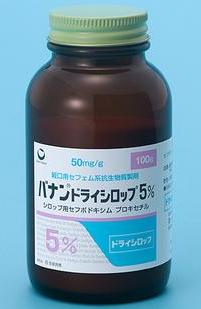|
英文药名;BAKTAR Combination Granules(Sulfamethoxazole/Trimethoprim)
中文药名:磺胺甲恶唑/甲氧苄啶颗粒组合
生产厂家:盐野义制药
バクタ配合顆粒
类别名称
合成抗菌剂
1. 一般的名称:スルファメトキサゾール(JAN)[日局]
Sulfamethoxazole
化学名:4-Amino-N-(5-methylisoxazol-3-yl)benzenesulfonamide
分子式:C10H11N3O3S
分子量:253.28
化学構造式:

性状:
白色结晶或结晶性粉末,没有气味,味道微苦。
N,N-二甲基甲酰胺以非常易溶,乙醇(95),以微溶,微溶于乙醚,在极微溶于水。
溶于氢氧化钠TS。
光逐渐着色。
熔点:169〜172℃
分配系数:7.76[1辛醇/水]
2. 一般的名称:トリメトプリム(JAN)[局外規]
Trimethoprim
化学名:2,4-Diamino-5-(3,4,5-trimethoxybenzyl)-pyrimidine
分子式:C14H18N4O3
分子量:290.32
化学構造式:

性状:
白色结晶或结晶性粉末,不臭,味微苦。
易溶于乙酸(100),甲醇,溶解度较小的稍稀乙酸或氯仿,乙醇(95)或微溶于丙酮,极微溶于水,并在乙醚中几乎不溶。
熔点:199〜203℃
分配系数:4.37[pH7.4,1-辛醇/缓冲]
适应病症
除用于脑膜炎球菌引起的脑膜炎的预防外,也用于敏感脑膜炎球菌所致的严重脑膜炎,敏感菌株所致的上呼吸道感染、中耳炎、产褥热、疖肿以及泌尿系感染、急性菌痢等。
1.一般感染症
成人,每日剂量4片(4克在颗粒的情况下)的2倍,并口服给药。然而,年龄,适当增加或根据状况减少。
2.肺肺炎治疗,抑制发病
(1) 在治疗中使用
成人,每日剂量9-12片(9-12克在颗粒的情况下)在三到四倍,并口服给药。
通常情况下,孩子们被分为每日剂量15-20毫克/公斤的甲氧苄啶,口服3-4次。
然而,年龄,适当增加或根据状况减少。
(2) 在抑制发病使用
正常,(在颗粒的情况下,1-2克)1-2片,每天一次对成人的每日或每周三天口服给药。
通常,儿童被分成一个每日剂量为4-8mg/kg的两倍甲氧苄啶,每天或周1天口服给药。
药效药理
1.药理作用
抗菌作用
在体外,甲氧苄啶,当每个单独作用相比诺明,两种药物的组合,观察到的抗微生物活性的协同增加时,作用杀菌。肠球菌属,显示大肠杆菌,痢疾杆菌,伤寒杆菌,副伤寒杆菌,柠檬酸杆菌,克雷伯菌属,肠杆菌属,变形杆菌属,摩根氏Morugani,普罗维登斯Rettogeri,针对流感嗜血杆菌的抗微生物活性。
2. 作用机序
诺明抑制微生物体内叶酸生物合成,甲氧通过抑制叶酸活化显示抗菌活性。对于两种药物的组合的协同抗微生物活性的增加抑制在同一时间叶酸代谢菌的两个连续地观察到。
包装规格
混合颗粒:
100克(瓶)

SP 100g(1G×100包)

制造厂商
盐野义制药有限公司
完整处方资料附件:http://di-pedia.com:808/DIC_GOOCO/Attach/6290100D1088_1_08.html
BAKTAR Combination Granules(バクタ配合顆粒)
Brand name : BAKTAR Combination Granules
Active ingredient: Sulfamethoxazole
Trimethoprim
Dosage form: white to light brownish white granules
Print on wrapping: バクタ 配合顆粒 1g BAKTAR
Effects of this medicine
This medicine is an antibacterial agent, called an ST combination preparation, and it consists of a combination of 2 active ingredients: one inhibits folate synthesis in microorganisms, and the other inhibits activation of folate.
It is usually used for the treatment of general infections such as respiratory infections, urinary tract infections, enteritis and abdominal typhus when other antibacterial drugs have no efficacy or can not be used, and the treatment and suppression of symptoms onset of pneumocystis pneumonia.
Before using this medicine, be sure to tell your doctor and pharmacist
•If you have previously experienced any allergic reactions (itch, rash, etc.) to any medicines.
If you have blood disorders (anemia, bleeding tendency, etc.) or a history of them, or deficiency of glucose-6-phosphate dehydrogenase (G-6-PD).
If you or your family members have an allergic tendency including bronchial asthma, rash, hives, etc.
•If you are pregnant, possibly pregnant or breastfeeding.
•If you are taking any other medicinal products. (Some medicines may interact to enhance or diminish medicinal effects. Beware of over-the-counter medicines and dietary supplements as well as other prescription medicines.)
Dosing schedule (How to take this medicine)
•Your dosing schedule prescribed by your doctor is <<to be written by a healthcare professional>>
•General infections: In general, for adults, take 2 tablets at a time, twice a day. The dosage may be adjusted to your age and symptoms.
Treatment of pneumocystis pneumonia: In general, for adults, take 9 to 12 tablets daily in 3 or 4 divided doses. For children, take 15 to 20 mg as trimethoprim per 1 kg of body weight daily in 3 or 4 divided doses. The dosage may be adjusted to your age and symptoms.
Suppression of symptoms onset of pneumocystis pneumonia: In general, for adults, take 1 or 2 tablets at a time, once a day, on consecutive days or 3 times a week. For children, take 2 to 4 mg as trimethoprim per 1 kg of body weight at a time, twice a day, on consecutive days or 3 times a week.
This product contains 80 mg of trimethoprim per tablet. In each case, strictly follow the instructions.
•If you miss a dose, take it as soon as you remember. If it is close to your next dose, skip the missed dose. You should never take two doses at one time.
•If you accidentally take more than your prescribed dose, consult with your doctor or pharmacist.
•Do not stop taking this medicine unless your doctor instructs you to do so.
Precautions while taking this medicine
•If you are breastfeeding, avoid breastfeeding while taking this medicine.
Possible adverse reactions to this medicine
The most commonly reported adverse reactions include rash, itch, redness, blister, hives, photosensitivity (exaggerated sunburn caused by sunlight, itch, pigmentation), headache, dizziness, light-headed feeling, feeling of numbness, tremor, lassitude, malaise, feeling drowsy and blood in stool. If any of these symptoms occur, consult with your doctor or pharmacist.
The symptoms described below are rarely seen as initial symptoms of the adverse reactions indicated in brackets. If any of these symptoms occur, stop taking this medicine and see your doctor immediately.
•palpitation, shortness of breath, light-headed feeling, fever, sore throat, bleeding tendency [aplastic anemia, hemolytic anemia, megaloblastic anemia, methemoglobinemia, pancytopenia, agranulocytosis, thrombocytopenia]
•malaise, fever, purpura (bruise) [thrombotic thrombocytopenic purpura, hemolytic uremic syndrome]
•feeling ill, swelling around eyes and/or mouth (lips), dizziness [shock, anaphylaxis]
•high fever, blister, inflammation in mucous membrane of eyes, mouth, etc., general redness [toxic epidermal necrolysis, mucocutaneous ocular syndrome]
•rash, fever, swelling of lymph nodes [drug-induced hypersensitivity syndrome]
The above symptoms do not describe all the adverse reactions to this medicine. Consult with your doctor or pharmacist if you notice any symptoms of concern other than those listed above.
Storage conditions and other information
•Keep the medicine out of the reach of infants and children. Store it at room temperature (1 to 30 degrees Celsius) away from light and moisture. This medicine may be colored by light.
•Discard the remainder. Do not store them.
Shionogi & Co., Ltd.Internal
Revised: 6/2014
The information on this sheet is based on approvals granted by the Japanese regulatory authority. Approval details may vary by country. Medicines have adverse reactions (risks) as well as efficacies (benefits). It is important to minimize adverse reactions and maximize efficacy. To obtain a better therapeutic response, patients should understand their medication and cooperate with the treatment.
|





